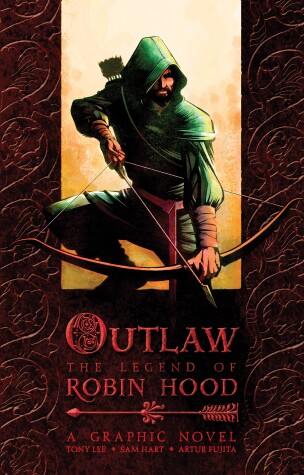Reviewed by Briana @ Pages Unbound on
When the story does depart from more traditional Robin Hood elements to original ones, the plotlines seems out of place. The book opens with Robin as a child, in an attempt to build something of a backstory for him. If anyone ever wanted to know exactly how Robin became good with a bow, or when he first romanticized the idea of becoming an outlaw, the answers are here. These moments are referenced frequently as Robin experiences flashbacks about them, and they are clearly meant to move the audience. They also humanize Robin, and he becomes less than legend in this book.
The book further departs from tradition by introducing an element of the supernatural. Sherwood, it seems, is haunted. No one can find Robin’s band because they are too fearful to enter the woods and look. Unfortunately, there is only a single encounter with spirits, near the beginning of the story, and then the matter is dropped. The subsequent absence of what had promised to be a major component of the book and Robin’s life is noticeable and could leave readers dissatisfied.
In terms of artwork, the first panel is spectacularly immersive, featuring a hooded outlaw perched among the branches of a large tree, seemingly aiming his bow straight at the reader as he demands a toll before he or she can move on. Unfortunately, this is the illustrator’s most brilliant moment, as the panels following never again incorporate the reader directly into the story or generally add much the text itself could not accomplish. Most of the panels are dark, making it difficult sometimes to tell which characters are speaking or what is happening in general. This can build an atmosphere of confusion for the reader that is fitting for a story based around conspiracies, but it also means that often there is not really much to look at.
Mostly, Outlaw stands on readers’ already formed love of the Robin Hood tale. The artwork has some interesting features, when visible, but readers will probably not be poring over it. The dialogue vacillates between being sassy and awkwardly phrased. The plot is fun—but it is standard. Barring the addition of Robin’s childhood years, most of it has been done before, in greater length and detail. Outlaw could serve as a fun introduction to Robin Hood, to familiarize young readers with the general idea of the story, or it could be a fun read for those interested in comparing different Robin Hood versions. In both cases, it needs to be read in comparison with other Robin Hood books because it is simply not remarkable enough to stand on its own.
Reading updates
- Started reading
- 16 June, 2013: Finished reading
- 16 June, 2013: Reviewed
